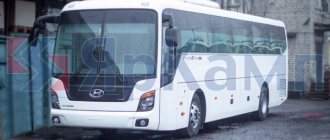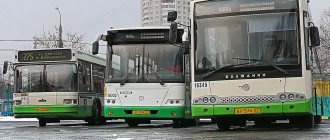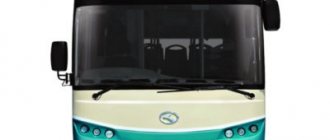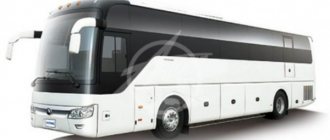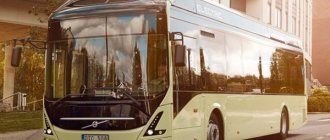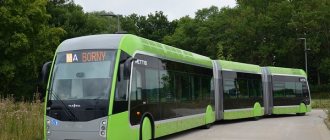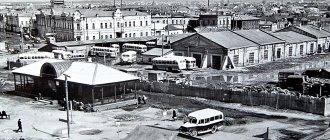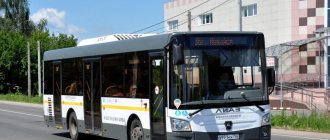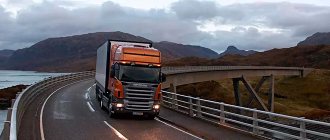From China for the discerning European
Daniil Minaev, photo by the author
This bus, despite all its external similarities, is not a Scania Higer A80, not an updated OmniExpress, and certainly not a “Cruise”. The listed models have in common only the basic chassis, but the constructive approach to creating the final product is completely different. Scania Touring is the subject of today’s conversation, a snow-white airliner aimed at the discerning European, not only a passenger, but also a driver and a mechanic. Russian customers, despite economic difficulties, have recently given preference to the Touring model, although they previously actively purchased the related, but simpler Scania Higer A80.
Snow-white liner
Scania Touring is not so young; the premiere of this bus took place in 2009 at the Busworld exhibition. The body and chassis are designed in Sweden, and production, organized in cooperation with Higer, is located in Shanghai. Touring cars come in different lengths and can have two or three axles. On request, the bus will be additionally equipped with a kitchen, toilet and driver’s berth, but Russian customers today prefer the simplest configurations without these amenities. But even in the basic equipment of the bus there is a lot of useful and interesting equipment, which I will touch on when describing systems and assemblies. For now, I’ll just note some details: automatically opening luggage hatches with pneumatic drive, the luggage compartment itself is ventilated, with a volume of up to 10 m3, depending on the equipment of the bus. The passenger compartment has 19-inch monitors, a video surveillance system, seats with a center offset function and adjustable footrests. There is no need to mention the air conditioning system, convector heating with an additional autonomous liquid heater and individual ceiling lamps - this goes without saying.
Custom blocks and curtains are very good
Scania city buses
Scania city buses are designed for use as urban passenger public transport and carry out mass transportation of passengers. The city bus has wide doors and passages, storage areas and handrails for standing passengers.
Scania city buses have the following characteristics:
- Spacious interior that can accommodate a large number of passengers with a small number of seats.
- Depending on the length of the bus, the number of doors is from 2 to 4.
- Storage areas, wheelchair accessible spaces and wide aisles.
- Handrails in the cabin for standing passengers.
The main parameters of a city bus are its capacity, the number of doors and the height of the cabin floor above the road surface.
Classification of a Scania bus depending on its length:
- Buses of small and medium capacity, the length of which is from 6 to 9 meters.
- Large city buses, up to 12 meters long.
Buses for urban transport can be of three types:
- Standard buses are used mainly for various mixed transport operations with long distances between stops, when the convenience of entry and exit does not become a fundamental factor. Often such buses are used on nearby suburban routes, so they have handrails and storage areas for incoming passengers.
- Low-floor buses have recently been used more and more and are replacing other buses in urban transport. The height of the entrance platforms in such buses does not exceed 200 mm, and the floor height is 300 mm. from ground level, due to which boarding and disembarking passengers becomes more convenient, and also facilitates safer opening of doors. As a rule, in such buses the number of seats does not exceed 30, and the main area of the cabin is given over to standing passengers (up to 110). The most modern low-floor city buses do not have any steps in the passenger compartments.
- Articulated buses include both low-floor and standard buses with a seating capacity of up to 80. Nowadays, articulated buses minimize the number of protruding surfaces for passenger comfort.
Invisible differences
To most accurately explain the philosophy of Scania Touring, I will give a humorous, not entirely parallel, but quite clear example from our recent history. In the best times for the Soviet automobile industry, many of our brands and models were exported. It was the export versions of our cars that were the pipe dream of a simple Soviet buyer, but with a certain amount of “blat” they could sometimes fall into the hands of a wealthy citizen of a totalitarian empire. The fact is that the export version meant not only significantly better assembly and painting quality, a beautiful color, but also such pleasant little things as an improved interior with a radio, imported lighting equipment and a whole range of high-quality foreign components that are in very short supply. So it is here. The A80 brother bus is built to a greater extent on components localized or simply produced in the Middle Kingdom. In addition to the main units, Touring has completely Swedish electrical wiring with its own special “intelligent” multiplex system, Kiel Avance passenger seats of German-American origin, and the noble origin of all finishing materials.
The mirror pillars do not protrude beyond the width of the bus and are equipped with additional spherical mirror elements in the middle of the bracket for better control of blind spots and curbs
Scania is one of the world's leading manufacturers of trucks and buses, as well as original spare parts for trucks. All brand products show reliable results even in difficult operating conditions.
In Russia, the Swedish concern is also represented by TulaScan, which over many years of successful work has won the trust of customers thanks to its impeccable service and European quality of products.
Scania is famous not only for its high-quality special equipment, which is designed for the most severe conditions, but also for passenger transport that meets all safety standards. If you want to buy a bus to transport passengers, then choosing the Scania brand is a great idea. Official dealerships and TulaScan have a large selection of Scania buses for various purposes, namely:
- city buses;
- tourist buses;
- intercity buses;
- station wagon buses.
Why should you choose Scania buses?
Transporting people means taking full responsibility for the safety of their lives. The Scania brand takes a responsible approach to the production of buses, so we can say with confidence that Scania buses fully meet all standards of safety, reliability, and passenger comfort. The Scania line of city buses is suitable for providing public transport. These models are distinguished by wide doorways, as well as the presence of comfortable seats for people with disabilities. Scania city buses come in small and medium capacity, from 6 to 9 meters in length, and you can also choose a large capacity of up to 12 m. For passenger comfort, there are several options for the appearance of the buses: standard, low floor or articulated. The Scania tourist bus is ideal for providing comfortable sightseeing trips. Depending on your preferences, you can change the parameters of capacity and configuration. Spacious interior, ergonomic and soft seats, air conditioning, individual lighting, convenient luggage compartment - even the longest excursion trip will remain in the memory of your passengers as a pleasant memory that they will definitely want to repeat. Leave a request on the website and our managers will promptly contact you and provide detailed advice on any issues related to the sale and service of Scania vehicles and equipment.
Panoramic view and smooth ride
Another feature of Scania Touring is common to many European buses - remote pillars with rear-view mirrors. In Touring, they do not protrude beyond the width of the bus and are equipped with additional spherical mirror elements in the middle of the bracket for better control of blind spots and curbs. The driver has no problems with visibility: a huge panoramic windshield with invisible, but very useful heating threads and thin pillars on the sides. To help the driver, there is a small monitor on the right hand, which broadcasts images from several cameras, thanks to which you can always see overtaking vehicles, minimize blind spots and protect yourself when reversing. In the dark, xenon headlights will help you cope with the road; in daylight, LED running lights will help you recognize the bus from afar. On the right side of the “torpedo” there is a refrigerator for drinks. The chassis confidently endures road adversities, demonstrating a normal smooth ride, lazily swaying with long overhangs. Now is the time to look into the engine compartment.
Engine compartment
The 13-liter, 400-horsepower Scania DC 13 engine of the fifth environmental class is practically inaudible inside: from the driver’s seat, all information about the operation of the power unit can be analyzed only by instruments, no noise, no vibrations. It’s just that 2100 Nm of torque already from one thousand revolutions per minute does not require much effort, especially without passengers. Similar engines are installed on other Scania vehicles, but the bus version, in addition to adjusting the external speed characteristics, also involves some mechanical differences, mainly in the drive of auxiliary units. Therefore, there are two powerful 150 A generators, a “multi-layer” crankshaft pulley with a separate output to a giant air conditioning compressor mounted on an elastic support. For stable operation of the belt drive, an additional stretcher with a threaded coupling is used. They didn’t forget about the service console in the engine compartment, and about the additional terminals of the pneumatic system, grouped on a separate panel on the right. This engine is paired with the familiar, latest-generation Opticruise GR875 8-speed automatic transmission, without a clutch pedal.
Technical characteristics of the Scania Touring K400 IB4x2NB bus
| Total weight, kg | 19 500 |
| Axle load distribution, kg | 7500/12 000 |
| Passenger capacity, persons | 51 |
| Luggage compartment capacity, m3 | 10,0 |
| Luggage compartment load capacity, kg | 770 |
Engine:
| Scania DC 13 (Euro 5) Diesel, I-6 12 800 400 at 1900 min-1 2100 at 1000–1300 min-1 |
Transmission:
| GR875 Opticruise Automated 8/1 |
| Suspension | Pneumatic |
| Brake system | Pneumatic, disc mechanisms on all axles, hydraulic retarder, EBS, traction control system |
| Tire size | 295/80 R22.5 |
| Wheel formula | 4x2 |
| Fuel tank capacity, l | 465 |
